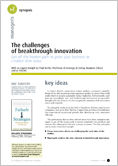Failsafe Strategies

Innovating means taking risks. To maximize the chances of success, companies must know which risks to take and how to minimize them if possible. The objective of Failsafe Strategies is to provide the keys to reach this understanding.
Author(s): Sayan Chatterjee
Publisher: Wharton School Publishing
Date of publication: 2005
Manageris opinion
Innovating means taking risks. To maximize the chances of success, companies must know which risks to take and how to minimize them if possible. The objective of “Failsafe Strategies” is to provide the keys to reach this understanding.
The book can be hard going at times, given its sometimes conceptual tone and a structure that is not always easy to follow. However, the rich content will amply reward readers who are willing to make the effort with good bases for analysis and wise suggestions.
– We recommend that you begin with chapter 2, which provides a very clear summary of the author’s theories on the three main risks connected with innovation, i.e. demand-related risks, competition-related risks and capacity-related risks. He uses a very detailed Southwest example to support these theories.
– Chapters 1 and 9 offer many ways to think about innovative offerings. They can be completed by reading chapter 10, which provides suggestions on how to choose between these different strategies.
– The author has a lot to say about the importance of managing capacity-related risk. Chapters 3 and 6 provide tips on how companies can actually maintain their value proposition to customers. Chapters 4 and 5 cover the question from a different angle, i.e. How to design innovative offerings that will not destabilize the entire company? Illustrated by examples of Lilly, FedEx and Sony, these chapters are among the most original of the book and deserve particular attention.
– Chapters 7 and 8, devoted to the implementation of incremental innovation strategies, seemed a bit out of synch with the main theme of the book. They make interesting asides, however.
